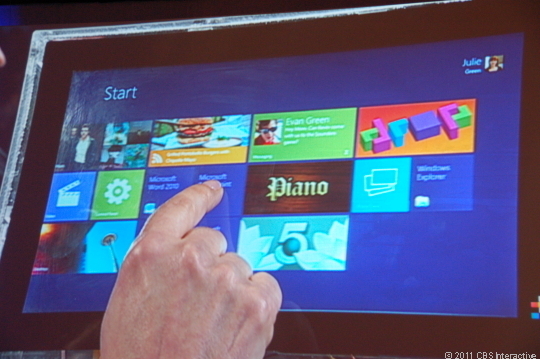Can Microsoft's Windows 8 really do it all?

Microsoft's demo of Windows 8 showed the company's path to tablets, a unique user interface and a lot of promise. But Microsoft's biggest risk with Windows 8 revolves around the familiar themes that always haunt the company: Reverse compatibility and the need to make Windows the Swiss Army knife of computing.
At AllThingsD's D9 conference Windows chief Steven Sinofsky highlighted Windows' futu
Can Microsoft manage all the complexity under the hood though?
Microsoft's Julie Larson-Green, vice president of Windows Experience, provides a set-up to Windows 8 that sounds great in theory, but ridiculously hard to pull off. Larson-Green noted "effortless movement between existing Windows programs and new Windows 8 apps."
Then Larson-Green got on the reverse compatibility train.
The full capabilities of Windows continue to be available to you, including the Windows Explorer and Desktop, as does compatibility with all Windows 7 logo PCs, software and peripherals.
Although the new user interface is designed and optimized for touch, it works equally well with a mouse and keyboard. Our approach means no compromises — you get to use whatever kind of device you prefer, with peripherals you choose, to run the apps you love. This is sure to inspire a new generation of hardware and software development, improving the experience for PC users around the world.
Related: Windows 8: Nice for tablets, but what about PCs?
- Microsoft's unanswered Windows 8 challenge - Legacy applications
- Gallery: Microsoft demos Windows 8 for tablets
- CNet News: The Windows 8 vs. iOS 6 face off
This immersive UI is the new start screen for all versions of Windows 8: The tablet versions, the laptop/notebook/netbook versions and the desktop PC versions. Users will be able to switch between this UI and a more conventional Windows Aero type interface, it seems.
Sounds great right? Except for the complexity. There's a reason why Apple has the iOS and the Mac OS. The devices those operating systems run are distinctly different. There are trade-offs involved. The iPad doesn't do everything. Microsoft---and to a lesser extent Android---want tablets to do everything. They want tablets to be PCs.
Daring Fireball's John Gruber gets to the point. Gruber likes the Windows 8 UI, but doesn't see Microsoft answering the iPad bell. Why? The Windows 8 model is too complex. Gruber writes:
Windows 8 is trying to have it all, and I don’t think that can be done. You can’t make something conceptually lightweight if it’s carrying 25 years of Windows baggage.
From a business perspective, Microsoft's approach is totally logical. You can't simply cut off the Windows base. That works for Apple, but won't fly with Microsoft, which has to reach back to support older platforms. Maybe virtualization ultimately helps this time machine support, but that approach can be clunky too. Perhaps if RIM's frankentablet works I'll be a believer.
Add it up and it's hard to do it all. Microsoft may be able to pull software engineering perfection, but no compromises usually means there really are some for users in the delight department.
Related: